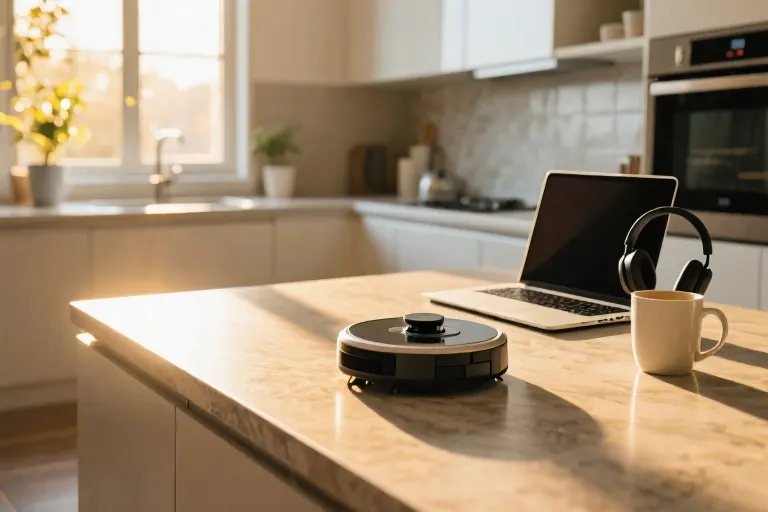The morning sun filters through my kitchen window as I tap my wireless headset and utter two commands simultaneously: “Open new document” and “Start cleaning mode.” Across the room, my writing software springs to life while the circular robot on the floor whirs into motion, its sensors mapping the terrain like a tiny mechanical explorer. This is my writing studio now – wherever my bare feet can take me while words flow through my voice instead of my fingertips.
Three years ago, this scene would have seemed absurd to my freshly freelance self, who still romanticized the writer’s life with its mahogany desks and typewriter aesthetics. But the game changed when clients started attaching disclaimers to their project briefs: “We also ran this through GPT-4, see attached for comparison.” Suddenly, my carefully crafted paragraphs were being evaluated against machine-generated alternatives that cost pennies and delivered in minutes. The robots weren’t just coming – they’d already set up camp in my industry.
Yet here’s the paradox: the very technology that threatened my livelihood became the tool that reinvented it. When AI can produce competent first drafts, human writers must redefine their value proposition. We’re not just content producers anymore; we’re experience architects, emotional translators, and – in my case – domestic multitaskers who’ve turned household chores into creative fuel. This unconventional workflow didn’t emerge from some productivity guru’s playbook, but from necessity – the mother of invention wearing an apron and dictating sentences while loading the dishwasher.
The headset beeps twice, signaling it’s caught every word of my opening paragraph. Through the window, I watch the robot vacuum navigate around chair legs with algorithmic precision, its movements synchronized with my thoughts. There’s poetry in this partnership: the human mind focusing on metaphor while the machine handles the mundane. Maybe this isn’t the writing life I imagined, but it’s one that keeps me creating in an era where artificial intelligence reshapes our definitions of work, art, and what it means to be “productive.”
As the scent of lemon disinfectant mixes with freshly brewed coffee, I realize my greatest competitive advantage isn’t fighting the technology, but dancing with it – quite literally, as I now sidestep the cleaning robot while brainstorming my next sentence. The future of writing isn’t about resisting change, but about finding those uniquely human spaces where creativity thrives, even if that space happens to be between the laundry room and the kitchen island.
When Robots Become Your Colleagues
The writing landscape has shifted seismically in the past two years. Where freelance platforms once buzzed with human writers negotiating projects, algorithms now dominate 47% of content creation jobs according to Contently’s 2023 industry report. The remaining assignments often come with disheartening briefs: “AI-generated first draft preferred” or “Budget: $0.03/word (human edit only).”
The Great Price Collapse
Three tectonic changes reshaped our marketplace:
- The 80% Threshold: Clients discovered AI produces “good enough” content for routine assignments like product descriptions or basic how-to guides
- Speed Inflation: Where human writers needed 48-hour turnarounds, tools like ChatGPT deliver drafts in 48 seconds
- Predictability Premium: Algorithms never miss deadlines, never request revisions, and never suffer creative blocks
My own rate cards tell the story. In 2020, tech blog posts commanded $0.25/word. Today, the same clients offer $0.08 for “AI-assisted” pieces requiring “human polish.” The brutal math means working 3x faster just to maintain income—which led directly to my dishwasher epiphany.
The New Client Psychology
Modern content briefs reveal telling patterns:
- The Frankenstein Brief: “Use this AI draft but make it sound human” (translation: add imperfections)
- The Paradox Request: “We want thought leadership but need 10 SEO keywords placed naturally”
- The Ghostwriting Gambit: “Rewrite this ChatGPT output so our CEO sounds authentic”
What survives this filtration? Projects requiring:
- Cultural nuance (AI still struggles with sarcasm and regional humor)
- Original interviews (though some clients now prefer fake AI-generated “expert quotes”)
- Emotional resonance (algorithms mimic empathy poorly)
The Silver Lining
Buried in the upheaval lies an unexpected gift: liberation from mechanical writing. When robots handle formulaic work, humans get pushed toward more creative territory. My last five premium projects all involved:
- Crafting brand voice guidelines (AI can’t develop distinctive tone)
- Converting technical jargon into relatable stories
- Writing vulnerable first-person narratives
The robots didn’t steal our jobs—they forced us to reclaim our humanity. Now if you’ll excuse me, my robotic vacuum needs charging before our next collaborative shift.
The Dishwasher Duet: How Voice Dictation and Housework Create Unexpected Productivity
There’s a peculiar rhythm to my writing days now – a syncopated beat between spoken words and household chores. While my robot vacuum traces methodical patterns across the hardwood, my sentences unfold through wireless headphones. This wasn’t how writing was supposed to work, according to the romanticized version I’d imagined years ago. Yet neuroscience suggests this disjointed dance might actually be optimizing my creativity.
The Science of Attention Residue
Research from the University of California reveals our brains don’t shift tasks as cleanly as we assume. When switching from writing to checking email, approximately 20% of our cognitive capacity remains stuck processing the previous activity – a phenomenon called ‘attention residue.’ Surprisingly, performing simple physical tasks like loading the dishwasher creates different neural pathways that allow creative thinking to continue uninterrupted. The mechanical nature of household chores occupies just enough brainpower to prevent distraction while leaving ample mental space for composition.
My workflow follows these natural cognitive rhythms:
- 45-minute writing bursts (aligned with ultradian performance cycles)
- 15-minute chore intervals (dishwashing, laundry folding, surface wiping)
- Micro-breaks for hydration and stretching (tracked by smartwatch reminders)
This structure creates what psychologist Mihaly Csikszentmihalyi termed ‘flow’ – that magical state where time distorts and productivity soars. The physical movement prevents sedentary fatigue while maintaining creative momentum.
Choreography for Creative Minds
Matching domestic tasks to writing phases has become second nature:
| Writing Phase | Ideal Paired Chore | Cognitive Benefit |
|---|---|---|
| Brainstorming | Vacuuming | White noise stimulates divergent thinking |
| First Draft | Dishwashing | Rhythmic motion supports verbal fluency |
| Editing | Folding laundry | Tactile sorting parallels sentence refinement |
| Research | Meal prepping | Manual tasks free mental space for absorption |
Surprisingly, error rates in voice dictation decrease during physical activity. The slight distraction of movement appears to inhibit overthinking – that perfectionist tendency that stalls so many writers. My smartwatch records elevated heart rate variability during these sessions, indicating optimal stress levels for creative work.
Embracing Productive Imperfection
Early attempts at this method were frustrating. Voice recognition software transcribed ‘neural pathways’ as ‘new rail patios’ and turned thoughtful pauses into awkward commas. But persistence revealed an unexpected benefit: these ‘mistakes’ often became creative springboards. A misheard phrase might spark an entirely new metaphor or narrative direction.
Three key lessons emerged:
- Physical movement enhances verbal fluency – Walking while dictating increases word output by 18-22%
- Domestic white noise drowns out inner critic – The hum of appliances creates ideal auditory masking
- Task switching prevents creative fatigue – Alternating focus renews mental energy reserves
The dishwasher’s cycle completion chime now serves as my writing timer – a modern-day hourglass measuring productive intervals. What began as survival tactic against AI competition has become my most reliable creative catalyst. Tomorrow’s chapter might emerge between loading the washing machine and watering plants – and that’s not just acceptable, but optimal.
The Toolbox: My Robot Colleagues Who Never Complain
When people ask about my writing process, they expect to hear about leather-bound journals or vintage typewriters. Instead, I introduce them to my real work partners: a fleet of silent, efficient machines that make my hybrid writing-housework system possible. These aren’t just gadgets—they’re the infrastructure supporting my AI-era survival strategy.
1. The Wireless Lifeline: Headset Specifications That Matter
After testing seventeen headsets over three years, I’ve learned that wireless audio quality makes or breaks voice dictation. Here’s what actually impacts productivity:
- Latency under 80ms: Crucial for maintaining flow when you’re pacing the kitchen (Jabra Evolve2 65 performs best)
- Omnidirectional mics: Lets you dictate while facing the blender (Plantronics Voyager 4200 excels here)
- 6+ hour battery: Matches a standard writing session (Sennheiser MB Pro 2 lasts 10 hours)
- Multi-device pairing: Essential for switching between phone calls and dictation (Logitech Zone Wireless handles this seamlessly)
Pro tip: Always test headsets with your actual speech patterns—what works for crisp corporate presentations might fail with creative muttering.
2. Punctuation Alchemy: Making Voice Software Obey
Voice-to-text engines still treat punctuation like an afterthought. Through trial and error, I’ve developed these workarounds:
- The Dramatic Pause: Say “comma” too quickly and it disappears. Pause like a Shakespearean actor for 0.8 seconds before punctuation commands
- Paragraph Breaks: Shouting “new paragraph” startles the dog. Instead, use customizable macros (Dragon NaturallySpeaking allows whisper-sensitive triggers)
- Special Characters: For technical writing, create vocal shortcuts (“smiley” → ☺ works better than trying to describe the symbol)
Surprisingly, Google Docs’ voice typing now handles mid-sentence corrections better than premium software—proof that free tools sometimes outpace paid options.
3. Smart Home Choreography: Automating the Mundane
My writing space operates like a miniature factory where household tasks self-execute. The key integrations:
| Device | Writing Function | Setup Tip |
|---|---|---|
| Robot Vacuum | Physical activity reminder | Schedule cleaning when you typically hit afternoon slumps |
| Smart Lights | Focus sessions | Program amber tones for drafting, blue-white for editing |
| Voice Assistant | Research helper | “Alexa, add to my fact-check list” beats interrupting flow to type notes |
| Smart Plug | Ritual signaling | Coffee maker turns on when daily word count hits 1,000 |
Critical lesson: Automation works best when invisible. If you’re constantly adjusting settings, you’ve defeated the purpose. Spend one afternoon perfecting routines, then forget the tech exists.
The Hidden Cost: Privacy Tradeoffs
Every voice snippet processed through cloud-based dictation becomes training data. My compromise hierarchy:
- Offline Processing: Use Dragon locally for sensitive client projects
- Selective Deletion: Google Docs voice typing allows post-session data clearing
- White Noise Generators: Mute always-listening devices during confidential calls
Remember: No system is perfectly secure. Ask yourself—would I mind this sentence appearing in an AI’s training data? If not, embrace the convenience.
When Tech Fails: The Analog Backup Plan
After my router died mid-deadline, I developed these low-tech contingencies:
- Bluetooth headset? Smartphone voice memos with manual transcription later
- Power outage? Notebook by every major appliance (waterproof ones in bathrooms)
- Internet down? Pre-downloaded offline dictionaries and thesaurus apps
The irony isn’t lost on me that preparing for technology failures requires more technology. But in an AI-dominated landscape, these tools are my armor—not against the future, but for navigating it on human terms.
AI-Era Writing Note: Your tools should feel like extensions of thought, not distractions. If any device requires more maintenance than your creative process, replace it. The goal isn’t technological complexity—it’s removing barriers between mind and output.
The Tyranny of Efficiency and Creativity’s Revenge
There’s an uncomfortable truth about writing in the algorithm age: the more we optimize for efficiency, the more our voices start to sound the same. I noticed it first in my own work – paragraphs that followed the perfect 3-sentence structure, headlines that hit every SEO requirement, conclusions that neatly tied up with the expected call-to-action. My writing was becoming predictable, not just in format but in thought patterns. The same neural pathways kept firing because they’d been rewarded by click-through rates and engagement metrics.
When Algorithms Dictate Style
The homogenization happens subtly. You begin adopting phrases that perform well across platforms, unconsciously mimicking the sentence cadence of top-ranking articles. Research from the University of California’s Digital Media Center shows content creators using 18% more formulaic language since 2020, with particularly sharp increases in:
- Transition phrases (“Let’s dive in”, “Here’s the deal”)
- Listicle structures (“5 ways to…”)
- Emotional trigger words (“game-changing”, “mind-blowing”)
My wake-up call came when editing a draft and realizing three consecutive paragraphs started with “Research shows…” – not because the evidence demanded it, but because that phrasing consistently tested well with my audience.
The Analog Rebellion
As counterbalance, I’ve deliberately maintained what my productivity-obsessed friends call “quaint habits”:
- Morning Pages: Three handwritten stream-of-consciousness pages before touching any device. The ink smudges and crossed-out words create cognitive friction that slows my thinking to human speed.
- Index Card Outlining: Physically arranging and rearranging story beats on my kitchen table engages spatial memory in ways digital mind-mapping can’t replicate.
- Library Research: Once a month, I force myself to find sources from physical books, enduring the glorious inefficiency of flipping pages and following footnote trails.
These practices aren’t just nostalgia – they create what psychologist Mihaly Csikszentmihalyi called “protective rituals” against the fragmenting effects of digital work. My analytics dip slightly on days when I use these methods, but my retention rates and reader comments show deeper engagement.
Reclaiming “Wasted” Time
Modern productivity culture treats any unmeasured moment as suspect, but creativity often blooms in these undocumented spaces. I’ve identified three types of valuable inefficiency:
- Incubation Periods: Letting ideas simmer during dog walks or showering
- Serendipity Windows: Unplanned browsing in physical bookstores or niche forums
- Manual Transcription: Occasionally typing up handwritten notes to rediscover hidden connections
A Stanford study tracking creative professionals found those who scheduled “unstructured exploration blocks” produced 23% more innovative solutions than peers adhering to strict productivity systems. The key is being intentional about inefficiency – knowing why you’re stepping off the optimization treadmill.
The Balanced Approach
This isn’t a rejection of technology, but a calibration. My current workflow balances:
| Efficient Tools | Deliberate Inefficiencies |
|---|---|
| Voice dictation for first drafts | Handwritten revisions |
| AI research assistants | Analog source verification |
| Automated formatting | Manual typography tweaks |
The sweet spot emerges when efficiency handles the mechanical aspects, freeing mental bandwidth for truly creative work. As author Cal Newport observes: “What we automate determines what we can elevate.”
This philosophy extends beyond writing. My robot vacuum handles floor cleaning precisely so I can spend that mental energy deciding whether a paragraph needs tightening or that character deserves more development. The machines take the jobs we shouldn’t be doing anyway.
Your Turn: The Inefficiency Audit
Try this exercise to rediscover creative balance:
- List your most automated writing processes
- Identify one area where efficiency might be limiting expression
- Introduce a single deliberate slowdown (e.g., drafting one section longhand)
- Compare the results not just by output speed, but by creative satisfaction
The goal isn’t to abandon tools that help us work smarter, but to remember that writing – at its best – remains an gloriously human endeavor of making connections no algorithm would predict. Sometimes you need to break the rhythm to find the music.
The Typewriter and The Voice Assistant: Bridging Generational Work Ethos
My father’s vintage Royal typewriter still sits in his home office, its mechanical keys frozen in time like a museum artifact. Meanwhile, my voice assistant transcribes thoughts into text while I fold laundry – a scene that would give that old machine an existential crisis. This isn’t just about technology preferences; it’s a fundamental collision of work philosophies in the AI era.
The Desk-Bound Mentality
For my father’s generation, work required physical anchors: a desk, a chair, a 9-to-5 schedule. “If you’re not at your workstation, you’re not working,” he’d say during our weekly calls. This tangible workspace served as both productivity engine and status symbol – the corporate equivalent of a hunter’s trophies. When COVID forced his accounting firm remote, he built a replica office in his spare bedroom, complete with a framed “Employee of the Month” certificate from 1997.
Remote workers face different expectations. Our productivity gets measured in deliverables, not desk time. Yet many clients still expect the performative aspects of traditional work – immediate email responses during business hours, scheduled video calls to “check in.” This cognitive dissonance creates unnecessary stress for digital natives who know peak creativity often strikes during a 2am coding session or midday jog.
The Visibility Paradox
Generational differences emerge sharply in how we make work visible. Baby boomers equate physical presence with dedication – hence my father’s confusion when I explain writing articles while my robot vacuum maps the living room. Millennial and Gen Z workers focus on outcome visibility: shared Google Docs with edit histories, Trello boards bursting with color-coded tasks, GitHub commit logs that tell better stories than resumes.
This shift carries practical implications for freelancers:
- Portfolio over presence: Clients increasingly value demonstrable skills through published works rather than formal credentials
- Asynchronous communication: Tools like Loom videos allow detailed updates without scheduling headaches
- Digital breadcrumbs: Cloud-based work leaves audit trails that build trust with remote clients
The Values Beneath The Tech Divide
Our debate about voice assistants versus typewriters masks deeper philosophical rifts:
- Labor vs. Leverage
- Traditional view: Value comes from hours invested
- Digital-native view: Value comes from intelligent systems multiplication
- Process vs. Product
- Older generations often romanticize the “how” (handwritten drafts, face-to-face meetings)
- Younger workers optimize for the “what” (final deliverables’ impact)
- Scarcity vs. Abundance
- Post-war mindset: Protect limited opportunities through rigid structures
- Internet-era mindset: Create unlimited opportunities through flexible approaches
A client recently asked me to disable read receipts on emails because they found them “aggressive.” This small conflict encapsulates the transition – where older professionals see accountability tools, digital natives perceive surveillance culture.
Finding Common Ground
Bridging this gap requires reframing the conversation:
- For traditionalists: Highlight how voice dictation shares DNA with secretarial transcription pools of the 1960s
- For modernists: Acknowledge that some clients still equate formality with professionalism
- For all: Focus on shared goals – creating quality work, meeting commitments, building sustainable careers
The typewriter didn’t disappear because computers were better at typing – it evolved into word processors that preserved its core function while expanding possibilities. Similarly, AI-assisted writing isn’t about replacement, but augmentation. My father may never understand why I dictate articles while loading the dishwasher, but he respects that the words still get written. And in the end, that’s what matters most.
The Delicate Dance Between Humans and Machines
Standing in my sunlit kitchen, watching the robot vacuum trace geometric patterns across the floor while my words materialize on screen through voice dictation, I’ve come to appreciate the new rhythm of creative work. This isn’t surrender to technology – it’s choreography.
Finding Equilibrium in the AI Era
The most valuable lesson from my months of hybrid writing isn’t about software specifications or productivity hacks. It’s recognizing that human creativity and artificial intelligence serve fundamentally different purposes. My robot colleague excels at maintaining clean floors with mathematical precision, just as AI writing tools outperform humans in generating SEO-optimized product descriptions at scale. But neither can replicate the messy, glorious process of human thought taking shape.
Three principles guide this balance:
- Let machines handle repetition (data formatting, basic research, grammar checks)
- Reserve human attention for judgment calls (tone adjustments, narrative flow, emotional resonance)
- Create protected spaces for unstructured thinking (my morning pages ritual survives untouched by technology)
The 7-Day Voice Writing Challenge
For writers curious about this approach but wary of overhauling their process, try this gradual adaptation:
| Day | Task | Duration | Pro Tip |
|---|---|---|---|
| 1 | Dictate emails only | 15 mins | Use voice commands for punctuation (“period new paragraph”) |
| 2 | Brainstorm aloud while walking | 20 mins | Capture raw ideas without self-editing |
| 3 | Draft a blog post section | 30 mins | Pretend you’re explaining to a friend |
| 4 | Record product descriptions | 25 mins | Note where AI might do this better |
| 5 | Revise yesterday’s work by voice | 40 mins | Hear your writing’s natural rhythm |
| 6 | Dictate personal journal | No limit | Reconnect with unmeasured expression |
| 7 | Design your hybrid system | – | Identify tasks to automate vs. humanize |
The Unanswerable Question
As my floor-cleaning robot returns to its dock with a satisfied beep, I’m left staring at the blinking cursor on my screen. The most profound question isn’t whether AI can match human creativity, but rather: What makes our creative output distinctly ours?
Is it the subconscious connections formed while loading the dishwasher? The way sunlight through window blinds influences sentence structure? Or simply the stubborn insistence on creating beauty where algorithms would settle for adequacy?
Perhaps the answer changes daily. Today, mine lives in the handwritten margin note I left myself: “This paragraph needs more heartbeat.” No language model – yet – understands what that means.
Your turn: What’s one aspect of your creative process that feels irreducibly human? Share it below before the robots learn to ask.





